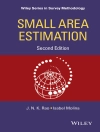An up-to-date approach to understanding statistical inference
Statistical inference is finding useful applications in numerous
fields, from sociology and econometrics to biostatistics. This
volume enables professionals in these and related fields to master
the concepts of statistical inference under inequality constraints
and to apply the theory to problems in a variety of areas.
Constrained Statistical Inference: Order, Inequality, and Shape
Constraints provides a unified and up-to-date treatment of the
methodology. It clearly illustrates concepts with practical
examples from a variety of fields, focusing on sociology,
econometrics, and biostatistics.
The authors also discuss a broad range of other
inequality-constrained inference problems that do not fit well in
the contemplated unified framework, providing a meaningful way for
readers to comprehend methodological resolutions.
Chapter coverage includes:
* Population means and isotonic regression
* Inequality-constrained tests on normal means
* Tests in general parametric models
* Likelihood and alternatives
* Analysis of categorical data
* Inference on monotone density function, unimodal density
function, shape constraints, and DMRL functions
* Bayesian perspectives, including Stein’s Paradox,
shrinkage estimation, and decision theory
สารบัญ
Dedication.
Preface.
1. Introduction.
1.1 Preamble.
1.2 Examples.
1.3 Coverage and Organization of the Book.
2. Comparison of Population Means and Isotonic
Regression.
2.1 Ordered Hypothesis Involving Population Means.
2.2 Test of Inequality Constraints.
2.3 Isotonic Regression.
2.4 Isotonic Regression: Results Related to Computational
Formulas.
3. Two Inequality Constrained Tests on Normal Means.
3.1 Introduction.
3.2 Statement of Two General Testing Problems.
3.3 Theory: The Basics in 2 Dimensions.
3.4 Chi-bar-square Distribution.
3.5 Computing the Tail Probabilities of chi-bar-square
Distributions.
3.6 Detailed Results relating to chi-bar-square
Distributions.
3.7 LRT for Type A Problems: V is known.
3.8 LRT for Type B Problems: V is known.
3.9 Inequality Constrained Tests in the Linear Model.
3.10 Tests When V is known.
3.11 Optimality Properties.
3.12 Appendix 1: Convex Cones.
3.13 Appendix B. Proofs.
4. Tests in General Parametric Models.
4.1 Introduction.
2.2 Preliminaries.
4.3 Tests of Rtheta = 0 against Rtheta >= 0.
4.4 Tests of h(theta) = 0.
4.5 An Overview of Score Tests with no Inequality
Constraints.
4.6 Local Score-type Tests of Ho : psi = 0 vs
H1 : psi &epsis; Psi.
4.7 Approximating Cones and Tangent Cones.
4.8 General Testing Problems.
4.9 Properties of the mle When the True Value is on the
Boundary.
5. Likelihood and Alternatives.
5.1 Introduction.
5.2 The Union-Intersection principle.
5.3 Intersection Union Tests (IUT).
5.4 Nanparametrics.
5.5 Restricted Alternatives and Simes-type Procedures.
5.6 Concluding Remarks.
6. Analysis of Categorical Data.
6.1 Motivating Examples.
6.2 Independent Binomial Samples.
6.3 Odds Ratios and Monotone Dependence.
6.4 Analysis of 2 x c Contingency Tables.
6.5 Test to Establish that Treatment is Better than Control.
6.6 Analysis of r x c Tables.
6.7 Square Tables and Marginal Homogeneity.
6.8 Exact Conditional Tests.
6.9 Discussion.
7. Beyond Parametrics.
7.1 Introduction.
7.2 Inference on Monotone Density Function.
7.3 Inference on Unimodal Density Function.
7.4 Inference on Shape Constrained Hazard Functionals.
7.5 Inference on DMRL Functions.
7.6 Isotonic Nonparametric Regression: Estimation.
7.7 Shape Constraints: Hypothesis Testing.
8. Bayesian Perspectives.
8.1 Introduction.
8.2 Statistical Decision Theory Motivations.
8.3 Stein’s Paradox and Shrinkage Estimation.
8.4 Constrained Shrinkage Estimation.
8.5 PC and Shrinkage Estimation in CSI.
8.6 Bayes Tests in CSI.
8.7 Some Decision Theoretic Aspects: Hypothesis Testing.
9. Miscellaneous Topics.
9.1 Two-sample Problem with Multivariate Responses.
9.2 Testing that an Identified Treatment is the Best: The
mini-test.
9.3 Cross-over Interaction.
9.4 Directed Tests.
Bibliography.
Index.
เกี่ยวกับผู้แต่ง
MERVYN J. SILVAPULLE, Ph D, is an Associate Professor in the
Department of Statistical Science at La Trobe University in
Bundoora, Australia. He received his Ph D in statistics from the
Australian National University in 1981.
PRANAB K. SEN, Ph D, is a Professor in the Departments of
Biostatistics and Statistics and Operations Research at the
University of North Carolina at Chapel Hill. He received his Ph D in
1962 from Calcutta University, India.












